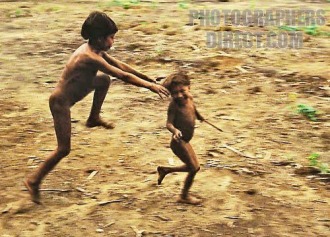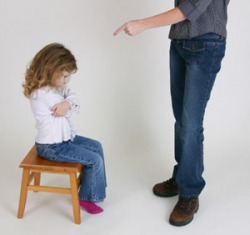DISCIPLINE: to what standards of behavior is a child held, & how are these enforced?
In both the YANOMAMIand JU'/HOANSI societies, a notion of high tolerance for child behavior prevails. Among the Yanomami, and particularly with boys, close proximity between parents and children does not infringe upon a child's freedom to act as he pleases. This laxity is most obvious when it comes to displays of physical violence(14). A boy is typically permitted to use force on other children. Little heed is paid when he strikes a peer with his hand or an object, and he is even allowed to abuse girls and rough up children who are younger than him! Furthermore, a young Yanomami boy who slaps his mother or father in the face as a show of temper often receives encouragement! In fact, a parent might even tease a boy to goad him into a violent response, which is met with praise. By such practices, a boy is taught that striking out with his hands or with a weapon is an appropriate expression of anger or agitation. This tolerant and even friendly attitude toward violence is not without purpose. It plays a fundamental role in cultivating the aggression that is so valued in the adult male Yanomami warrior. Violence is not instilled in children to the same extent by Ju'/hoansi parents, but discipline is equally absent, especially for boys(15). In these two foraging societies, childhood freedom trumps enforced conformity to rules.
Child discipline is a more heavily emphasized and enforced in SUBURBAN AMERICA. In a culture where manners, composure, and conformity are valued above volatility and display of force, parents have traditionally concentrated on curbing aggressive and disobedient behavior through their disciplinary practices(16). In the child's early developmental stages, significant emphasis is also placed on correcting its inclinations toward selfish satisfaction of desires and whims. Modes of discipline include stern speech, raising of the voice, withholding of privileges, and the occasional incidence of corporal punishment, though this is waning in American society as attitudes toward it grow more and more negative.
References:
14. Chagnon 1992
15. Barnard 1992
16. Reese and Lipsitt 1978
Child discipline is a more heavily emphasized and enforced in SUBURBAN AMERICA. In a culture where manners, composure, and conformity are valued above volatility and display of force, parents have traditionally concentrated on curbing aggressive and disobedient behavior through their disciplinary practices(16). In the child's early developmental stages, significant emphasis is also placed on correcting its inclinations toward selfish satisfaction of desires and whims. Modes of discipline include stern speech, raising of the voice, withholding of privileges, and the occasional incidence of corporal punishment, though this is waning in American society as attitudes toward it grow more and more negative.
References:
14. Chagnon 1992
15. Barnard 1992
16. Reese and Lipsitt 1978


